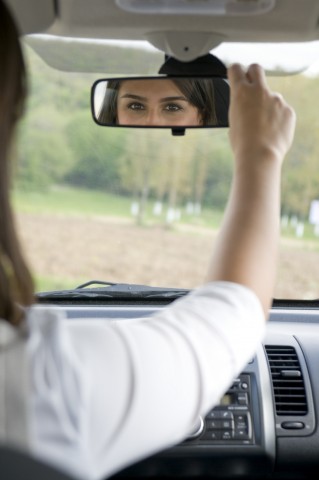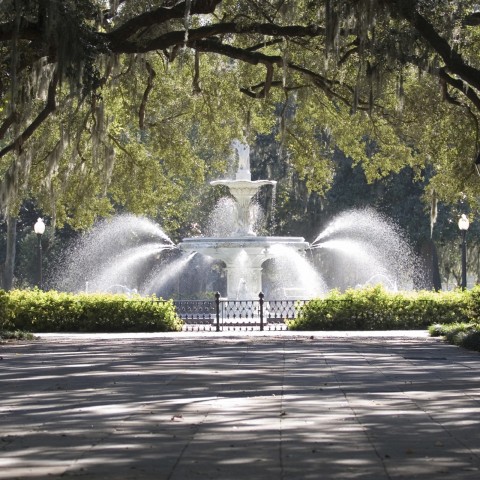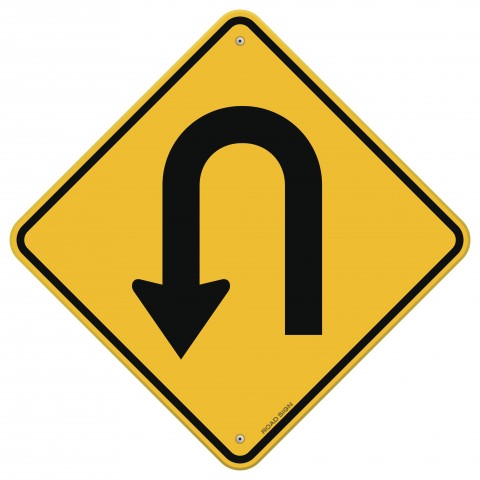
Knowing how to get from point A to B, especially in a new environment, is paramount. Having things to do and places to go in a new location is meaningless if you have no idea how to get there. Asking for directions (and giving them) in their own language is one of the most important skills a person can have—making it even more vital when visiting a country that speaks a different language.
Learn how to ask and give directions in English with EnglishClass101’s complete guide to directions in English!

Table of Contents
- Cardinal Directions in English: Using North, South, East & West
- Giving Road Directions in English
- Describing Directions in English with Landmarks
- Must-know Phrases for Asking Directions
- Must-know Phrases for Giving Directions
- Putting it All Together!
- Conclusion
1. Cardinal Directions in English: Using North, South, East & West

1- Basic Directions
As you may know, there are four basic directions on a compass or map:- North: On a traditional map orientation, North is up.
- South: On a traditional map orientation, South is down.
- East: On a traditional map orientation, East is to the right.
- West: On a traditional map orientation, West is to the left.
2- Combinations
There are also terms for the directions between the four compass directions in English that you should be aware of:- Northwest: This refers to the direction between North and West.
- Northeast: This refers to the direction between North and East.
- Southwest: This refers to the direction between South and West.
- Southeast: This refers to the direction between South and East.
3- Talking About Directions on a Map

There are a few basic sentence patterns you should know when learning about English directions:
- ___ [place] is ___ [direction word] of ___ [another place].
- [Oregon] is [south] of [Washington].
- ___ [town/city] is in the ___ [direction word] part of ___ [country].
- [San Diego] is in the [western] part of [the United States].
- ___ [country] is to the ___ [direction word] of ___ [another country].
- [The United States] is to the [south] of [Canada].
- ___ [specific place] is to the ___ [direction word] of ___ [another place].
- The [San Diego Zoo] is to the [north] of [San Diego].
- Note here that you can also say: “The [San Diego Zoo] is in [northern] [San Diego].”
You may have noticed in a couple of examples that the direction word ended with “-ern.” This suffix is added to a direction word when it’s used as an adjective to describe a nonspecific area. For instance, in the second example, “western” is used to describe San Diego’s general direction within the U.S, not a specific area or direction.
Other examples include:
- Northern hemisphere
- Eastern heritage
- Southwestern food
2. Giving Road Directions in English

Now that you understand the basic map directions, it’s time to learn how to ask and give directions in English. More specifically, how to do so on the road.
It’s unlikely that you’ll use north, south, east, and west when trying to find a specific place. For example, when you’re roaming the streets of Seattle, Washington looking for the Fremont Troll, these basic directions just won’t cut it.
1- Basic Opposites
When learning about directions in the English language, there are some common words you’ll often hear and use when looking around for different places. Here, I’ve paired opposites and their definitions so you can grasp the meaning of each. These are useful for giving street directions in English, in particular.
1. Front & Back
“Front” refers to being towards the face of something; “back” is the opposite, or being towards the opposite side of that thing. Here are some basic examples of how you may hear these words used in directions:
- The bookstore is to the front of the park.
- The police station is to the back of the park.
2. Left & Right

“Left” refers to the left-hand side, while “right” refers to the right-hand side.
- You’ll find the hotel on the left.
- Turn right at the stop sign.
3. Far & Close
“Far” means that something is a long distance away from where you are now. “Close” means that something is nearby.
- The Metropolitan Museum of Art is pretty far from here.
- But Mount Rainier is close.
4. In front of & Behind
If something is “in front of” something, it means that it’s to its face. If something is “behind” something, it’s to its back.
- The library is in front of the grocery store.
- The grocery store is behind the library.
5. Up & Down
“Up” can either refer to the direction of the sky, or to an increase in elevation. “Down” can either refer to the direction of the ground, or to a decrease in elevation.
- I like looking up at the sky. [Direction of the sky]
- Take the elevator up to the third floor. [Increase in elevation]
- Don’t look down! [Direction of the ground]
- The ball slid down the ramp. [Decrease in elevation]
6. Over & Under
“Over” refers to crossing on top of something, and “under” refers to crossing beneath something.
- Cross over the John F. Kennedy Memorial Bridge.
- Pass under the bridge and then turn left.
7. Across from & Next to
If something is “across from” something, it means that it’s directly facing it from a distance (usually with something in-between them, like a road or a lake). If something is “next to” something, it’s beside it.
- Barbara’s house is across from Sara’s.
- Jill sat next to Bill in class.
2- With References
Here are some common phrase patterns you’ll hear when being given directions. Many of these phrases contain words from the list above. If you want even more examples, you can check out our relevant vocabulary list.
1. Next to ___
If something is “next to” something else, it’s adjacent to it (directly beside it).
- The hair salon is next to the game shop.
- You’ll find the museum next to the park.
2. ___ away from
This phrase refers to something’s distance from another position, either in terms of measurable distance or time.
- The Grand Canyon is about one-hundred and thirty-five miles away from the Horseshoe Bend.
- The pizzeria is about five minutes away from the apartment.

3. Across the street from ____
When someone uses this phrase, it means that the location you’re looking for is separated by a street from something else.
- Across the street from the apartments, you’ll find the ice cream shop.
- The ranch is across the street from the high school.
4. By the intersection
An “intersection” is a place where the roads join, usually from four different directions, and traffic from each road must wait to make a turn or continue forward. This phrase indicates that the location you’re looking for is near an intersection.
- The church is by the intersection.
- The farmer’s market is located by the intersection.
5. Around the corner
“Around the corner” refers to turning left or right around the corner.
- Drive around the corner, and you’ll find the music shop.
- The Gettysburg National Military Park is just around the corner.
6. Up/down the road
Oftentimes, people will tell you to go up or down the road. Going “up” the road usually means going in the direction that it’s most elevated (e.g, slightly uphill), and going “down” the road usually means going in the opposite direction.
People often use hand gestures to show you which way you should go, especially when you’re not sure.
- The next gas station is just up the road.
- Go back down the road a few miles to find the rest stop.
7. Near the ___
This phrase means that the place you’re looking for isn’t far from the place mentioned.
- The Bronx Museum of the Arts is near the Yankee Stadium.
- St. Patrick’s Cathedral is near the Rockefeller Center in New York.
8. To the right/left of ___
This is a common phrase to use with landmarks (which I’ll discuss more below). It means that you should turn right or left at a specific place or within proximity of a certain object. It can also be used to show you where to look, as in the examples below.
- There’s a sign to the right of the road.
- If you look to the left of the mountain, you can see an airplane.
9. Close to the ___
This phrase is practically the same in meaning as “near the ___” and is used exactly the same way.
- The fire station is close to the main road.
- Stay close to the freeway exits.
10. In front of/Behind the ___
To be “in front of” something means to be at its face. To be “behind” something is to be at its back. This phrase is often used to let you know where something is in relation to something else.
- You pay for your tickets in front of the arena.
- The supermarket is behind the cafe.
3. Describing Directions in English with Landmarks
Landmarks are special objects or other defining factors that make an area distinct from others. Landmarks can be manmade and intentional, or they can be everyday objects like trees, rocks, and even graffiti.
People frequently use landmarks when giving directions to someone, as it makes the directions less daunting and more specific. I know I feel more comfortable following directions when I hear words like “big tree,” “farm,” or “hotel,” instead of “Go due northeast fifty-two miles blah blah blah.”
Here are some common landmarks and phrases you may hear when someone gives you directions during your travels.
1- In the City
- Airport
- Turn left at the airport.
- Subway station
- When you see the subway station, make a right turn.
-
- City center/downtown
- Once you reach the city center, keep going straight through.
- Park
- You need to turn right at the park.

- Hotel
- The first thing you’ll see after you turn is a big hotel.
- Hospital
- You can find the diner near the hospital.
- Bank
- From the bank, make a left.
- [Restaurant name]
- When you see the McDonald’s, pull in and turn around.
- [Famous landmark]
- At the end of the Golden Gate Bridge, keep going straight.
- Railroad tracks
- Cross the railroad tracks, and go down the road a few miles.
- Mall
- After you pass the mall, make a left onto the next street.
2- On a Road
- Intersection
- Make a right at the second intersection.
- Traffic light
- At the traffic light, make a left.
- Crosswalk
- After you’ve made it over the crosswalk, make a right turn.
- Newspaper stand
- Go around the corner where that newspaper stand is.
- Gas station
- The hotel is just a few miles up the road from the gas station.
- Rest stop
- From the rest stop, go back a few miles.
- Stop sign
- Keep going straight at the stop sign.
- Farm
- Make a right on the road just after the farm.
- [Road name]
- Make a left on Rose Petal Lane.
3- In a Structure or Building

- Restroom
- Turn the corner where the restroom is.
- Elevator
- At the elevator, turn right.
- Gate
- Wendy’s is just across from Gate 3.
- Parking lot
- You’ll find the front office just across this parking lot.
- Meeting room
- After you pass the meeting room, turn left.
- Terminal
- Go straight through Terminal 1.
- Parking garage
- It’s on the third floor of the parking garage.
- Gym
- Just before the gym, make a right.
- Drinking fountain
- Make a left at that drinking fountain.
- Breakfast room
- Past the breakfast room, you’ll find an elevator.
4. Must-know Phrases for Asking Directions

When asking about directions in English, it’s always a good idea to include a polite beginning phrase, your question or need, and a courtesy or thank you phrase.
1- Polite Beginning Phrases
People tend to be more receptive and helpful when you begin with a polite phrase. These are some common ones:
- Excuse me…
- Pardon me…
- Sorry to bother you…
- May I ask…
- Do you happen to know…
You can also combine some of these phrases to create a better-sounding sentence. Most of the time, you’ll want to start your polite phrase with one of the first three phrases, followed by one of the latter two phrases.
- Excuse me, may I ask…
- Pardon me, do you happen to know…
- Sorry to bother you, may I ask…
2- Questions
After your polite phrase, you can ask your question. There are a few different question formats you can use:
- …where ___ is?
- May I ask where Main Street is?
- …where I can find ___?
- Do you happen to know where I can find the Six Flags amusement park?
- …how to get to ___?
- Do you happen to know how to get to the subway station from here?
- …how far ___ is?
- May I ask how far Universal Studios is?
- …if ___ is far from here?
- Sorry to bother you… May I ask if the Hollywood Walk of Fame is far from here?
3- Courtesy Phrases / Thanks
After the person you’re talking to has given you directions (or guided you to someone who can help), it’s always good to thank them. Here are the most common ways to do so:
- Thank you.
- I see, thank you.
- I appreciate your help.
4- Examples
Here are some examples of how to ask for directions, using the above phrase formats.

- Excuse me, where is the restroom? … Thank you!
- Sorry to bother you, how do I get to the Prescott Valley Event Center? … I see, thank you.
- Pardon me, may I ask how far Disneyland is from here? … I appreciate your help.
5. Must-know Phrases for Giving Directions
Let’s say that someone asks you for directions. How do you tell them which way to go, or what steps to take to reach their destination? In this section, I’ll go over a few of the most basic and practical phrases you can use and their definitions.
1- Street Phrases

- Go straight
- This means to continue going in the direction you’re facing.
- “At the library, go straight.”
- Go straight until ___
- This means the same thing as above, but also includes information on when to stop.
- “Go straight until you reach the traffic light.”
- Go back
- This means to go in the opposite direction.
- “When you reach the bookstore, go back.”
- Go back until you reach ___
- This means the same thing as above, but also includes information on when to stop going back.
- “Go back until you reach the Pahranagat National Wildlife Refuge.”
- Make a U-turn
- A “U-turn” (sometimes called a “U-ey”) is when you change direction by turning in the shape of a “U.” Always watch out for signs that prohibit this, though.
- “Make a U-turn before you reach the next rest stop.”
- Turn left/right
- This means that you make a left or right turn.
- “Then turn left/right.”
- Turn left/right at ___
- This means the same thing as above, but includes information on where exactly to make the turn.
- “Turn left/right at the stop sign.”
- Stay on ___ [road/street] until ___
- This one’s a little more complex, and means to stay on the same road until a certain point is reached.
- “Stay on Pheasant Drive until you reach Cherokee.”
2- For Buildings
- On the ___ floor
- Use this phrase to specify what floor of a building something is on.
- “You can find Mr. Reynolds on the third floor.”
- Go upstairs/downstairs
- Use this phrase to tell someone to change floors either up or down via the stairs.
- “Go upstairs to reach him.”
- Take the elevator
- Use this phrase to tell someone to change floors either up or down via the elevator.
- “Take the elevator down to the basement.”
- The room to the left/right OR The room straight ahead
- Use this phrase when indicating a specific room.
- “The bathroom is the room to the right.”
- “You can find a vending machine in the room straight ahead.”

- Just around the corner
- Use this phrase to let someone know that all they have to do is turn the corner to find what they’re looking for.
- “There’s a drinking fountain just around the corner.”
- You’ll see a ___ [marker of some sort]; ___ [direction] here.
- This one is more complex. Use it to indicate a landmark or specific object, and tell the person what to do once they reach it.
- “You’ll see a ficus plant; turn left here.”
3- Driving Directions in English
- Keep going
- Use this phrase to tell the person driving to continue going in the same direction.
- “Keep going until you reach the intersection.”
- Stop
- Use this phrase to tell the person driving to stop the car.
- “Stop at the nearest gas station.”
- Hurry up / Go faster
- Use this phrase to tell the person driving to speed up the car and drive faster.
- “When we reach the freeway, hurry up a little / go faster.”
- Slow down
- Use this phase to tell the person driving to drive slower.
- “Slow down once we reach town.”
- Turn right/left at ___
- Use this phrase to tell the person driving to make a turn at a specific point (e.g. a stop sign or traffic light).
- “Turn right/left at the church.”
- Turn right/left in about ___ [estimate of distance]
- Use this phrase to tell the person driving to make a turn after they’ve driven a certain distance.
- “Turn right/left in about five miles.”
- At the ___ turn right/left
- This phrase is similar to the two previous phrases. Use this phrase to indicate where the person driving should turn.
- “At the gate, turn right/left.”
4- Reassurances

Reassurances can make all the difference when giving someone directions, especially if that person is frantic to find the place or is running late. Here are a few phrases you can use to ensure that the other person remembers and understands your directions, which will make both of you feel better.
- You won’t miss it.
- You can use this phrase to let the person know that what they’re looking for (whether their destination or a landmark) is easy to find, and that they’ll know when they reach it.
- You’ll know you’re there when ___.
- This is similar to the above phrase, but offers information on what to expect or look for at a certain point.
- Did you get that?
- Asking the other person if they “got” your directions (meaning to remember and understand the directions) gives them a chance to ask you to repeat the directions if needed.
Other ways to ensure that the person you’re giving directions to arrives safely at their destination include:
- Offering a description of the place
- Repeating the directions
- Asking them to repeat the directions back to you
5- What if You Don’t Know?
If you’re new to the area (or just bad with directions, like I am…), you probably don’t know how to help. In this case, just say so:
- I’m sorry, but I don’t know where that is.
- I’m sorry, I’m new here too.
- I’m not sure how to get there, sorry.
If you happen to be in a public area (such as a hotel lobby or restaurant), you can also suggest that they talk to someone more knowledgeable—like a receptionist or server.
6. Putting it All Together!

So, what do you do with all of these words and phrases? What do they look like in an everyday conversation about directions? In this section, I’ll provide an example conversation about directions in English using more complex directions based on those I outlined in this complete guide to directions in English. This should give you a better idea of how to ask and give directions in English.
—
You’re visiting the state of California and want to hit most of the tourist attractions before you leave. Right now, you’re on your way to SeaWorld but have gotten lost along the way. You pull over into a gas station and go inside to ask the clerk for directions:
You: Excuse me, how do I get to SeaWorld from here?
Clerk: It’s just south of here. Keep going down the road, then around the corner. From there, keep going straight until you see Montgomery-Gibbs Executive Airport, and then make a left on Kumeyaay Highway. Follow the road until you reach SeaWorld. Trust me, you won’t miss it.
You: Thank you, I appreciate your help.
Clerk: No problem. Did you get all that?
You: [Repeats directions.]
Clerk: Good. Have fun.
7. Conclusion
I hope you learned something new about giving and asking for directions in English, and that you feel more comfortable doing so. Understanding directions in English will take time and practice, but we know you can do it. Is there anything you’re still unclear about? Let us know in the comments!
To continue learning about the English language, explore EnglishClass101.com and start using our range of fun and practical learning tools. You can read more insightful blog posts like this one, study free English vocabulary lists, and chat with fellow English learners on our community forums. For a more personalized and guided learning experience, you can also upgrade to Premium Plus and take advantage of our MyTeacher program!
English is not an easy language to learn, but your determination and hard work will pay off, and you’ll have our constant support along the way. You’ll be able to speak, read, and write in English like a native before you know it! 🙂










